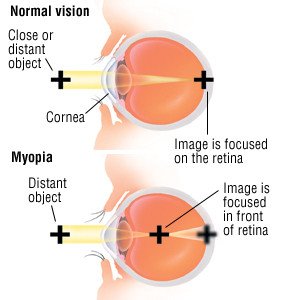Causes and Risk Factors for Nearsightedness
Most commonly, nearsightedness is an anatomical issue, resulting from an eyeball that's too long, which prevents light from focusing directly on the retina (the "screen" at the back of your eye). Nearsightedness can also be caused by a cornea (the clear layer at the front of the eye) that's not shaped correctly.
Duration of Nearsightedness
Treatment and Medication Options for Nearsightedness
LASIK (Laser-Assisted In-Situ Keratomileusis) In this procedure, an ophthalmologist first cuts a round, hinged flap in your cornea.
Using an excimer laser (which, unlike other lasers, produces no heat), the doctor will remove layers from the center of your cornea to change its shape and improve your vision.
LASEK (Laser-Assisted Subepithelial Keratectomy) In this procedure, the doctor works only on the cornea's thin outer layer (epithelium).
After creating a flap, the doctor then uses an excimer laser to reshape the outer layer of the cornea.
PRK (Photorefractive Keratectomy) In this procedure, which is similar to LASEK, the epithelium is completely removed by the doctor.
After using the laser to reshape the cornea, the doctor does not replace the epithelium, which grows back and conforms to the new shape of the cornea.
- Under- or overcorrection of your original vision problem
- Vision problems, such as halos or other effects around bright lights
- Dry eye
- Infection
- Corneal scarring
- Vision loss (in rare cases)
Medication Options
Nonmedical Therapies
Prevention of Nearsightedness
Research and Statistics: Who Has Myopia?
Related Conditions of Nearsightedness
Degenerative Myopia This form of myopia is relatively rare but, as noted above, it’s a leading cause of legal blindness, as it damages the retina.
Resources We Love
Favorite Orgs for Essential Myopia Info
National Eye Institute (NEI)
The NEI gives readers detailed background information on myopia, from risk factors to prevention including a description of what exactly goes wrong in eye development to cause the condition. The site also presents current research around myopia, including its own National Institutes of Health–funded studies and clinical trials.
Mayo Clinic
A nonprofit with a broad reach into clinical practice, education, and research, the Mayo Clinic provides extensive, patient-friendly background on myopia. Treatments for nearsightedness are presented clearly and are regularly updated, so readers will find actionable guidance. Those who have upcoming ophthalmologist visits can also read advice on how to prepare and what questions to ask the doctor.
American Optometric Association (AOA)
The AOA represents more than 44,000 doctors of optometry in the United States, and is an authority on eye care and optometry. The website covers the essentials of myopia, such as diagnosis and various treatments.
Additional reporting by Sarah Amandolare.
Editorial Sources and Fact-Checking
- Nearsightedness: Symptoms and Causes. Mayo Clinic. April 2, 2020.
- Vitale S, Sperduto RD, Ferris III FL. Increased Prevalence of Myopia in the United States Between 1971-1972 and 1999-2004. JAMA Ophthalmology. December 2009.
- Nearsightedness (Myopia). National Eye Institute. September 8, 2020.
- Myopia (Nearsightedness). American Optometric Association.
- The Myopia Boom. Nature. March 18, 2015.
- Myopia (Nearsightedness). Cleveland Clinic. July 14, 2020.
- Nearsightedness: Diagnosis and Treatment. Mayo Clinic. April 2, 2020.
- LASIK Eye Surgery: About. Mayo Clinic. November 8, 2019.
- Tay SU, Farzavandi S, Tan D. Interventions to Reduce Myopia Progression in Children. Strabismus. February 6, 2017.
- Four Alternatives to Eyeglasses for Children. American Academy of Ophthalmology. June 25, 2020.
- Multifocal Contact Lenses Slow Progression of Myopia in Children. National Eye Institute. August 11, 2020.
- Wu PC, Tsai CL, Wu HL, et al. Outdoor Activity During Class Recess Reduces Myopia Onset and Progression in School Children. Ophthalmology. May 2013.
- Myopia: A Close Look at Efforts to Turn Back a Growing Problem. National Eye Institute. October 3, 2017.
- With Childhood Myopia Rates on the Rise, the American Optometric Association Highlights the Importance of Early Intervention through Annual Eye Exams. American Optometric Association. March 1, 2019.
- Nearsightedness (Myopia) Data and Statistics. National Eye Institute. July 17, 2019.
- Proportion of Patients Who Had an Eye Exam in Selected Year. Centers for Disease Control and Prevention: Vision and Eye Health Surveillance System.
- Luong, T, Shu, Y-H, et al. Racial and Ethnic Differences in Myopia Progression in a Large, Diverse Cohort of Pediatric Patients. Investigative Ophthalmology and Visual Science. November 2020.













































